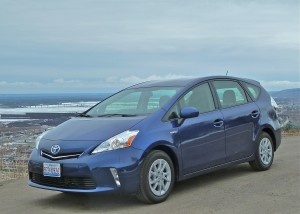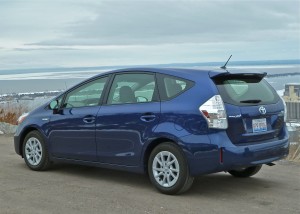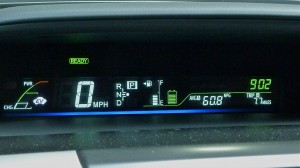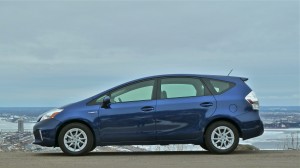Prius V gives Toyota versatile hybrid entry
By John Gilbert
The world of alternative-energy vehicles is expanding virtually by the month, or week. Hybrid vehicles, electric cars, turbo-diesels, cars with tiny gas engines, and combinations of those, such as turbo-hybrids, all seem to have validity and are marketed to be better than the others. All we know is, there is no single answer to the problem of clean and efficient running, just a number of varied answers, all contributing to a cleaner world of automotives.
It makes sense, then, to reboot the ol’ analytical brain by going back to Toyota, to examine how and where the Prius is situated. The Prius was the first hybrid, although it was beaten to U.S. sales outlets by Honda with its Insight. Since then, The Prius has soared to great popularity, outselling all hybrids with the trusty Hybrid Synergy Drive.
The Prius line itself is almost a separate entity. While Toyota became best-known for its top-selling Camry midsize sedan, when car-buyers slowed down and then retrenched, many observers now say that Toyota is best identified by the Prius line. Along with the standard Prius compact sedan, Toyota brought out two cousins, the subcompact Prius C this year, and the elongated Prius V a year ago.
The Prius V is best described as a wagon-like hatchback with the same drivetrain as the standard front-wheel-drive Prius, but with a larger storage area behind the back seat and a higher, squared-off roof. While the smaller Prius C starts at just over $20,000, and the plug-in version of the Prius sedan can run to a high of over $30,000, the Prius V is priced at between $27,500 and $30,000.
Like the basic Prius sedan, the Prius V uses a 1.8-liter 4-cylinder engine, which produces 132 horsepower as the base engine in the Corolla and Matrix. In the hybrid, it is coordinated with the electric motor powered by a nickel-metal-hydride battery pack. Most competitors have chosen to switch to lithium-ion battery systems, and Toyota does use one in its plug-in Prius versions.
In the Prius and Toyota systems, the gas engine alone doesn’t move the vehicle, instead sending power through a generator to make electric driving power when called upon for hard acceleration or when the battery pack is drained. In combination, the Prius V has 134 horsepower, which is misleading, because the kick from the electric motor is instant. And, the V has all the assets of the normal Prius with the added asset of that huge storage space.
While nobody ever accused the Prius of being a neck-snapper for acceleration, the longer and larger Prius V also is modest in its performance. But with a rocker switch allowing the driver to choose EV, Eco, or Power, there is a distinct variation possible. In Power, the gas engine kicks in harder and with plenty of force for freeway merging or other power needs. The EV setting keeps you in full electric as long as possible, while the Eco setting combines the gas and electric for normal operation. Switching from Eco to Power gives the Prius V a considerable boost, although it might cut into the chances of reaching the optimum 50 miles per gallon.
A continuously variable transmission, quick, electric steering, and firmly stable suspension make the Prius satisfying to drive, and because it operates more on electric with less need for the gas engines in slower driving, and shuts off every time you stop at a red light, the Prius V gets better fuel economy in city driving.
It’s always fun to drive a hybrid, because you alter your habits to try to extract high mileage. Cutting down on the bursts of acceleration, easing up to stop signs and stoplights, and being satisfied with only mild acceleration to get up to cruising speeds are among the driving tips that reduce the amount of input you take from the 1.8-liter gas engine.
During our week with the car, I averaged between 42 and 44 mpg in mostly urban driving, and we stayed at just about 42 mpg on a freeway trip. That set the stage for me to focus in on one session to see what I might achieve from the mileage computer.
Mostly coasting down the long hill to a stretch of freeway, the gauge flashed up to 90, and even 99 mpg, and I realized that was not realistic, so when I got on the freeway and eased up to 65 mph, I zeroed the computer again. Holding steady at 65, then driving 30 through part of town, 50 on a short stretch of freeway, then exiting and going up a hill before finding a spot to park, I checked the computer again. It showed that on my particular 10-mile segment, I had averaged 60.8 mpg.
Now, that doesn’t mean I could get that all day, or every day, or guarantee that anyone could expect that, but it does prove that such mileage is possible, without hyper-mileage driving, and sticking to normal, everyday style.
The Prius V driving position is very good. Supportive seats, good ergonomics, and excellent visibility make it easy to find an optimum spot from which to drive and see. The visibility is aided by the unusual positioning of the instruments and the navigation screen, which are at the top of the center stack, leaving nothing but a sloping dashboard in front of the steering wheel, with no instrument pod to peer over. The shift lever juts out from the dash, also, and it moves only from reverse to neutral and drive, and when you stop, you push a separate button for park, and another for the keyless shutoff.
Much to my surprise, the narrow tires on the Prius V, designed to optimize fuel economy, also worked well in foul weather. My wife, Joan, drove from Duluth, Minnesota, to Minneapolis and back in one day, nearly 350 miles altogether, and a late-April snowstorm deposited 7 inches of snow in Minneapolis, up to 18 inches in Duluth. Joan said she saw at least a dozen cars off the freeway on her return trip, but she never spun a tire, including making it through our driveway and into our garage.
The Prius V was never promoted as a “winter beater,” but if that is just an added asset to its capabilities, it was a welcome bonus to prove Toyota hasn’t lost its touch in keeping the Prius at the cutting edge of the hybrid game.
Comments
Tell me what you're thinking...
and oh, if you want a pic to show with your comment, go get a gravatar!






 John Gilbert is a lifetime Minnesotan and career journalist, specializing in cars and sports during and since spending 30 years at the Minneapolis Tribune, now the Star Tribune. More recently, he has continued translating the high-tech world of autos and sharing his passionate insights as a freelance writer/photographer/broadcaster. A member of the prestigious North American Car and Truck of the Year jury since 1993. John can be heard Monday-Friday from 9-11am on 610 KDAL(www.kdal610.com) on the "John Gilbert Show," and writes a column in the Duluth Reader.
John Gilbert is a lifetime Minnesotan and career journalist, specializing in cars and sports during and since spending 30 years at the Minneapolis Tribune, now the Star Tribune. More recently, he has continued translating the high-tech world of autos and sharing his passionate insights as a freelance writer/photographer/broadcaster. A member of the prestigious North American Car and Truck of the Year jury since 1993. John can be heard Monday-Friday from 9-11am on 610 KDAL(www.kdal610.com) on the "John Gilbert Show," and writes a column in the Duluth Reader.